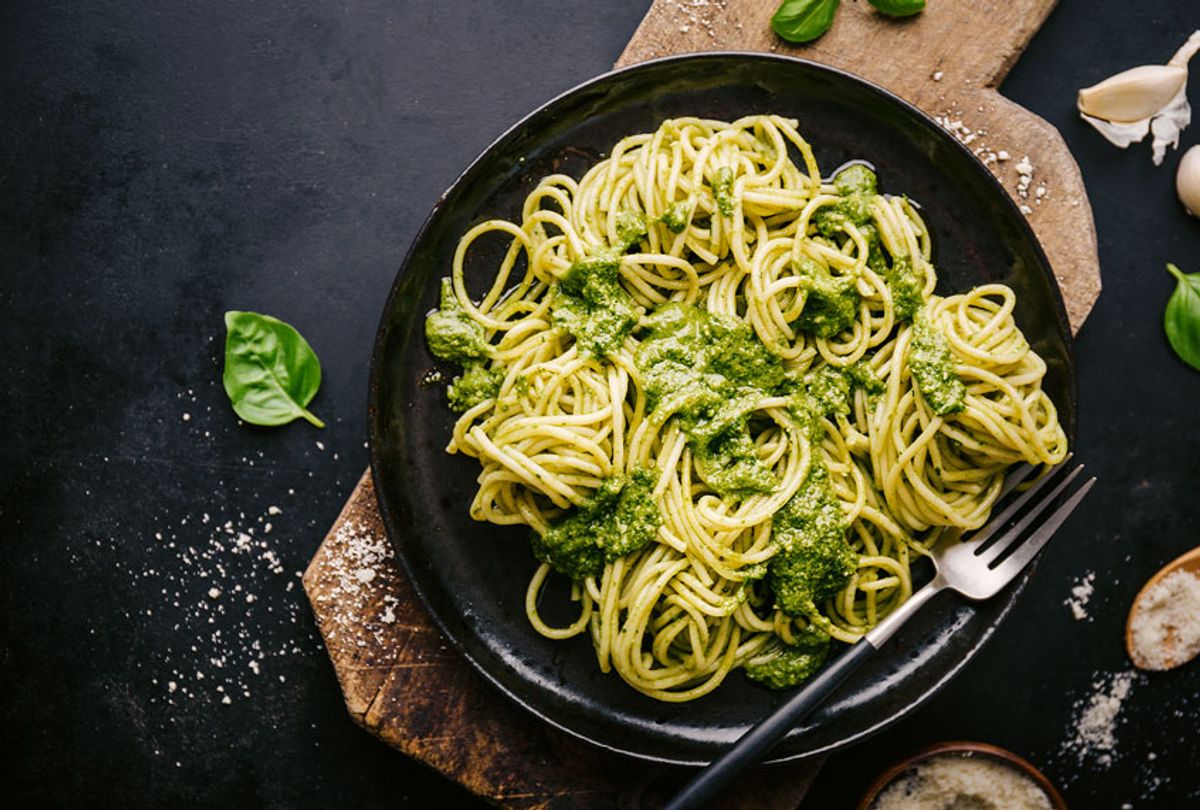Some of the keys to elevating your home cooking are probably sitting in your trashcan right now. Many of the pieces of food that we toss — the vegetable scraps, citrus skins, and past-ripe berries — can be repurposed, with a little effort, into ingredients that will take your meals to another level.
This cuts down on food waste, keeps meal costs low, and opens up the possibility for unique dishes without running to the grocery store for specialty ingredients. Here are five suggestions:
Have leftover kale ribs? Make pesto.
Reserve the ribs — the woody stem part — from a bunch of kale; there should be about 1 ½ or 2 cups. Give them a rough chop and place in a food processor. Place ¼ cup of shelled pistachios on a sheet pan and lightly toast in the oven until lightly browned, 5 to 7 minutes at 250 degrees. Add the pistachios, ⅓ cup of grated parmesan and 2 garlic cloves to the food processor and pulse until a thick paste forms. Add ⅓ cup of extra virgin olive oil to the processor and continue processing until smooth.
Remove the pesto from the processor, add to a large bowl and season with salt and pepper to taste. Finish with ½ teaspoon of grated lemon zest (or preserved lemon peel! Check out the recipe below).
This pesto can be used to coat pasta or cooked vegetables, as a sauce to liven up cooked beans, or as a sandwich condiment (grilled cheese with provolone, roasted red peppers and pesto? Yes, please!)
Onion and shallot skins? Add them to stock.
While it's easy to think of the papery skins of onions and shallots as throwaway packaging, they can provide a really beautiful color and subtle flavor to vegetable stock, which is really the ultimate way to use up vegetable scraps. The key is roasting all the vegetable bits until browned before adding to the stock pot.
Preheat the oven to 300 degrees. Add two cups of leftover vegetables — mushroom stems, carrot and leek ends, fennel bulbs, green bean tips, corn cobs, winter squash skins and any wilting herbs like parsley or cilantro are all great options — to a sheet pan. Add 1 thinly-sliced, unpeeled onion or 5 thinly-sliced, unpeeled shallots and 4 unpeeled garlic cloves to the pan and drizzle everything with olive oil. Generously salt and pepper.
Bake the vegetables for 60 to 70 minutes, flipping halfway through.
Transfer the vegetables to a stock pot, and cover it with 12 cups of water. Add 1 teaspoon of black peppercorns and 2 bay leaves. Bring the stock to a boil, then reduce it and simmer for 80 minutes, stirring occasionally, until stock has reduced by half.
Let the broth cool, then strain, discarding solids.
Are your berries busted up? Transform them into cocktail shrubs.
You know that package of berries that is sitting in the back of your refrigerator; they're not rotten by any means, but they are a little past their prime? My current favorite use for those is making shrubs. A shrub is essentially a drinking vinegar that can be used to add a little pucker to cocktails or non-alcoholic mixed drinks.
Bring 1 pint (2 cups) of mixed berries, 1 ½ cups of apple cider vinegar and ¼ cup of white sugar to a boil in a medium saucepan. Quickly remove from heat and allow the mixture to steep for at least 30 minutes. Strain the mixture into a glass jar or other airtight container and chill until cold.
Now it's cocktail time: add 2 tablespoons of the mixed berry shrub, 3 ounces of gin, 2 ounces of fresh (or bottled) lime juice and a few dashes of Angostura bitters to a glass filled with ice. Finish off with a pour of club soda.
For a non-alcoholic version, simply omit the gin and substitute club soda.
Have extra lemon skins? Preserve them.
Lemon skins are an MVP ingredient in my kitchen (and home bar) because they are so versatile, and one of my favorite ways to keep 'em around is to preserve them.
Take the "husks" of 5 spent lemons and remove the peel, taking care to slice away any remaining flesh or pith. Add a 1-inch layer of salt to a glass jar, topping it with the peel of one lemon; alternate between salt and lemon until all the peels are covered. Seal tightly, and store that jar in a cool, dark place for about six weeks.
At this point, your lemon peels are ready to use. Mince them and sprinkle overtop of pasta, peas or avocado toast. They are also a fantastic addition to salad dressings and dips like labneh.
Got herb stems and olive pits? Elevate your olive oil.
In my pantry I have two kinds of olive oil. There is my splurge bottle — you know, the one that I felt a little uncomfortable handing my credit card over for — and my "meh" bottle. I have feelings about the splurge bottle. I use it gingerly to finish off meals or when I want something decadent to dip a crusty loaf of bread in.
My "meh" bottle is affordable and gets the job done; it's for coating and sauteing and mixing.
But I recently found that herb stems and olive pits — potentially two of the most "meh" ingredients of all — can help elevate a basic bottle of oil into a pretty stellar one by adding some subtle spiciness and sweetness. Simply add the a few olive pits and the stems of herbs like rosemary, thyme and parsley to a glass jar filled with olive oil (this reduces the shelf life of your oil, so you'll want to only add as much oil as you'll use in a two week timeframe) and allow it to infuse for at least four hours. Strain the mixture, removing the stems and pits, and return the oil to the jar.

Shares